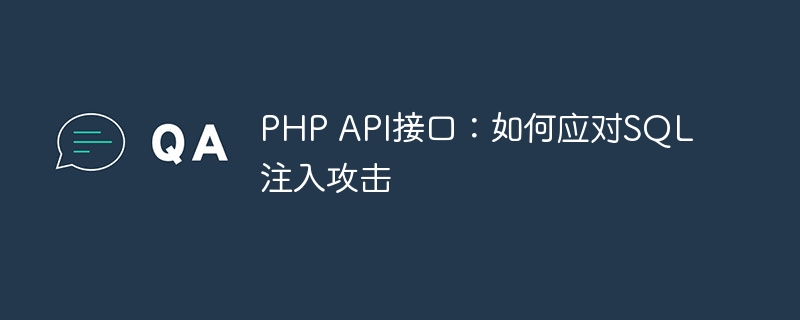

As a popular back-end language, PHP is often used to develop web applications or APIs, providing developers with a lot of convenience and flexibility. However, for any kind of web application or API, there is the same security risk: SQL injection attack. This article will lead readers to understand what SQL injection attacks are and how to prevent and respond to this type of attack by writing PHP code.
What is SQL injection attack
SQL injection attack refers to the behavior of an attacker inserting malicious code into the database query of a web application or API. These malicious codes can cause damage or leakage to the database and its related information, such as deleting, modifying, and viewing data in the database.
Attackers using SQL injection attacks usually do so by guessing the SQL query statements in the application or API. Attackers exploit vulnerabilities in an application or API by sending specially designed malicious code (such as SQL query strings) to the application or API, thereby inserting malicious code into database queries. These malicious codes can somehow steal, tamper with, or delete data from the database.
SQL injection attacks are particularly dangerous in processing user input. Some developers may splice user input directly into the SQL query, which facilitates SQL injection attacks.
Best practices for dealing with SQL injection attacks
Listed below are some best practices for dealing with SQL injection attacks:
When developing an application or API, it is very important to avoid splicing user input directly into SQL queries. Instead, you should use parameterized query statements to build queries. Parameterized queries allow developers to specify parameters to be used in the query, rather than directly splicing user input into the query.
Using parameterized queries can effectively prevent SQL injection attacks and improve query performance.
The following is an example of a parameterized query using PDO:
$pdo = new PDO('mysql:host=localhost;dbname=mydb', 'username', 'password');
$stmt = $pdo->prepare('SELECT * FROM users WHERE username = :username');
$stmt->execute([
'username' => $_POST['username']
]);
$result = $stmt->fetchAll();When processing user data, filtering user input is also very important of. Filtering user input ensures that only validated input reaches the database query. Here are a few ways to filter user input:
The following is an example of using PHP's built-in filter to filter user input:
$username = filter_input(INPUT_POST, 'username', FILTER_SANITIZE_STRING);
Displaying detailed error messages in production environments should be avoided whenever possible. If an error occurs, a useful error message should be provided to the user, but detailed error information should not be exposed on the web interface, as attackers can use this information to conduct targeted attacks.
The following is an example of disabling detailed error messages in PHP:
error_reporting(0);
ini_set('display_errors', 0);It is also very important to encrypt the database password. If the database password is not encrypted, an attacker can easily obtain the password and access the database.
The following is an example of using a hashed password to encrypt a database password:
$password = 'mypassword'; $hashed_password = password_hash($password, PASSWORD_DEFAULT);
Backing up the database regularly is also important to deal with SQL injection attacks step. In the event of an attack, you can use backup files to restore a compromised database.
Conclusion
SQL injection attacks are a common threat to all web applications and APIs. By following the above best practices, developers can prevent and respond to SQL injection attacks right from the code level. Not only will this make your application more secure, but it will also make your users trust your application more.
The above is the detailed content of PHP API interface: How to deal with SQL injection attacks. For more information, please follow other related articles on the PHP Chinese website!